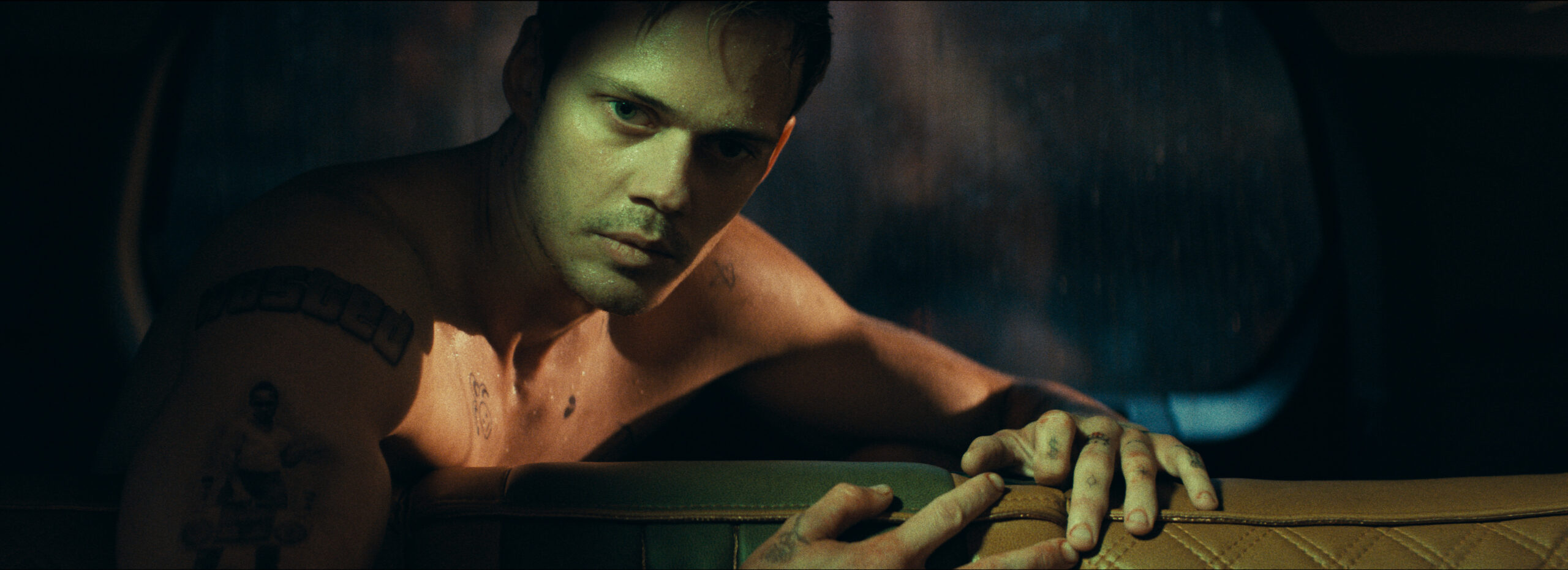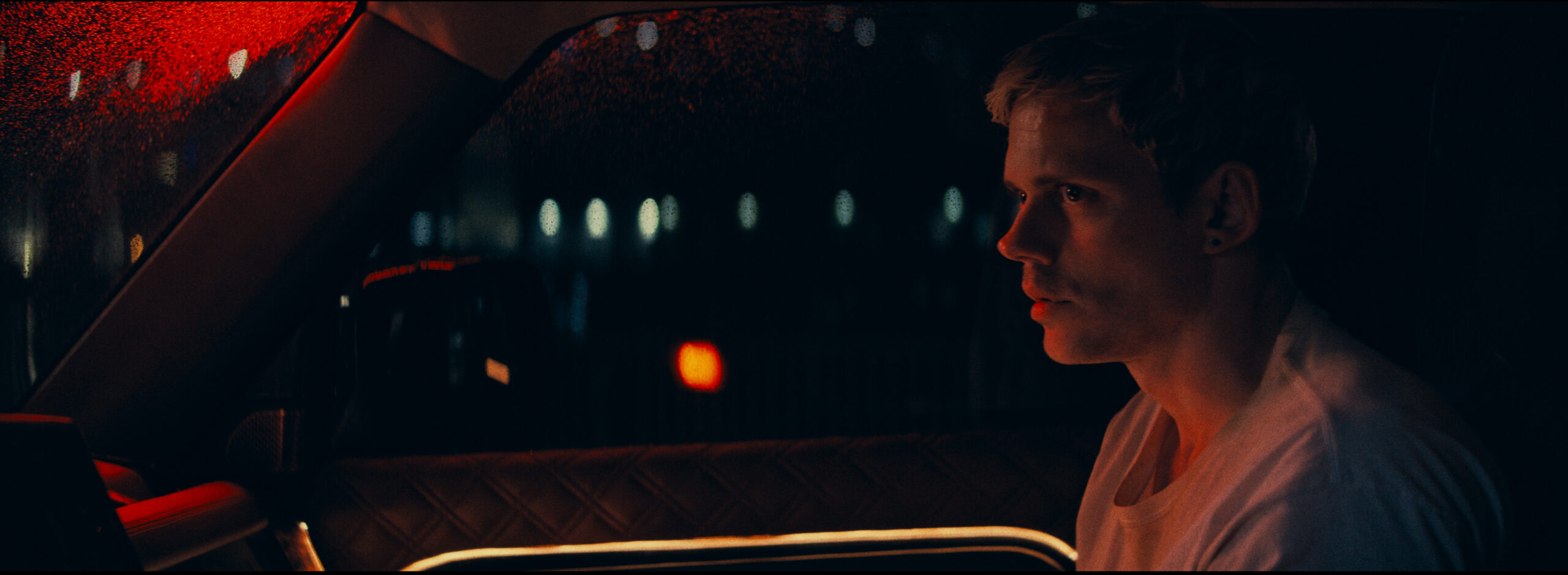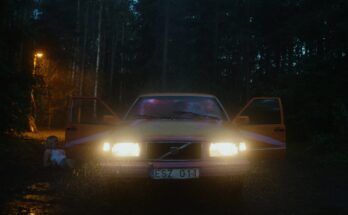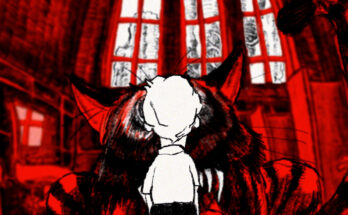Want to hear more from the actors and creators of your favorite shows and films? Subscribe to The Cinema Spot on YouTube for all of our upcoming interviews!
Managing editor & film and television critic with a Bachelor's of Arts in English Literature with a Writing Minor from the University of Guam. Currently in graduate school completing a Master's in English Literature.
Pennywise versus Hannibal Lecter in a quite grounded face-off—this is what director David Yarovesky had in mind when putting both Bill Skarsgård and Anthony Hopkins through the motions of their collaborative feature, Locked. Based on Mariano Cohn and Gastón Duprat’s 2019 Argentinian crime thriller, 4×4, this horror thriller inserts its lead, Eddie Barrish (Skarsgård), into a dehumanizing space, bouncing between righteousness and depravity. With Locked, Yarovesky spearheads his most intense project since May 2019’s Brightburn. The result is an edge-of-your-seat suspenseful window into what it means to be a person in the world.
Locked is written by executive producer Michael Arlen Ross (Wrong Turn, Turistas) and is directed by David Yarovesky (Brightburn, Nightbooks).
In this review, I will discuss David Yarovesky and Michael Arlen Ross’s Locked. As the title of this review suggests, there will be no spoilers.
Locked Synopsis
According to Brigade Marketing’s production notes, here is the official synopsis for Locked.
From producer Sam Raimi (Evil Dead, Drag Me to Hell) comes a relentless horror-thriller where luxury becomes deadly. When Eddie (Bill Skarsgård) breaks into a luxury SUV, he steps into a deadly trap set by William (Anthony Hopkins), a self-proclaimed vigilante delivering his own brand of twisted justice. With no means of escape, Eddie must fight to survive in a ride where escape is an illusion, survival is a nightmare, and justice shifts into high gear.
Brigade Marketing
Discussion
Yarovesky and Ross’ storytelling, the DOLUS vehicle designs and the environmental set piece, as well as the performances between Skarsgård and Hopkins are pivotal elements in making Locked a vessel for greatness. However, these elements can only take this hour-and-thirty-five-minute narrative so far. Even reading the production notes, wherein Yarovesky describes protagonist Eddie Barrish’s conflict as “a claustrophobic, psychological battle”, should be the tip of the iceberg amongst other expectations. After two viewings, though, it becomes clear that Locked is truly an immersive experience for genre fans.
If nothing else, immersion is primarily the aim, and I constantly catch myself noting the different narrative hurdles in the asserted statements. For one thing, Yarovesky states that “a confined space can be the most terrifying place of all”. This aspect remains true, given what many have read in Edgar Allan Poe’s “The Cask of Amontillado” short story or have seen in James Wan and Leigh Whannell’s first Saw film. While the victims of the latter are restrained to their impenetrable chains, Barrish can move about within an SUV, whose metal layers and two-inch-thick windows prove humanly difficult from ever breaking out.
Secondly, the director argues against the fear of the unknown, a widely renowned phobia based on factors exterior to reason. This claim within the production notes piqued my interest most of all considering what Barrish discovers both in his immediate surroundings and outside the vehicle in the real world. I understand what known factors play against him—i.e. the need to see his family again and the prospect of returning home—and therefore affect the character on a psychological level. Barrish is provided with little resources in William’s (Hopkins) vehicle compared to, say, the main character in Kōbō Abe’s The Woman in the Dunes.
Ross’s Script
Locked‘s storytelling is a driving force testing the limits of human survival. The production notes cite the plot as a transformation from “what could have been a straightforward thriller into something far more sinister and layered”. Seeing that horror veteran Sam Raimi is a producer here is evidence of the idea ringing true. It was easy for me to pass this title off as a cheap, generic genre flick. However, when viewers actually start empathizing with Barrish, it takes on more profound meaning. Imagine a child or a dog locked inside of a car with no windows cracked open. Now, imagine that beloved somebody is Bill Skarsgård. The horror-thriller taps into the suffocation of an individual supplied with oxygen every so often through air-conditioning vents.
The screenplay is mostly fine, although I’m unsure where to identify the concrete beats. Ross doesn’t showcase the full logistics of the story and how the world-building works. For example, how does William get alerted or notified of the break-ins happening to his car? Does its battery not die out, and how does the physiology behind that exactly work? Similarly, how mindful is Barrish of his cellphone’s battery life? Where do Barrish’s partner, Amy (voiced by Gabrielle Walsh), and their daughter, Sarah (Ashley Cartwright), fit in besides being at the goalposts of his self-destructive nature?
The audience is expected to rely on characters’ beliefs and choices. That simply does not impress as trustworthy ethos. My sole explanation for Barrish’s psychotic break has to be the consequence of a severe psychosis triggered earlier on. Survival scenarios such as this can lead to painful outcomes, as it had with Saw and Scott Mann and Jonathan Frank’s Fall. The narration isn’t reliable enough and just seems as if the viewers are barred from discovering the full truth.
Dualisms
Locked is obscure about the themes it concentrates on. Instead, it often looks to its two lead characters to represent the dualities of man. If anything, the film does a nice job of juxtaposing between polar opposites, e.g. inside and outside, danger versus safety, labor versus laziness, poor versus rich, the young versus the more experienced, the Self and the Other, morality versus immorality, and life and death, etc.
Ross’s reference to Russian author Fyodor Dostoevsky’s popular novel, Crime and Punishment, is an excellent example discussed here. Barrish is urged into reflecting on his life and actions and is thus reminded of what is right and what is wrong. The film does call upon Marxist thought in one of its best-written scenes, brought to life by Skarsgård and Hopkins’ exchanges. It goes so far as to deal with the Social Security system and calling out celebrity Kim Kardashian’s law practice pursuits. Additionally, the frame at the beginning of the final act of ants crawling over a dead gray animal—either a pigeon or a rodent—is a creative metaphor for the less fortunate overcoming those larger in the food chain.
Unfortunately, what Locked comes down to is the challenging viewpoints between a Boomer and a Millennial. The film’s final act just writes everything off as “young people are the scum of the Earth” and “only older people hold wisdom”. I would have loved more deep conversations such as that explained in the previous paragraph to have been had. Yet, Ross excuses this by making William a sinister antagonist without even the slightest affection left over in him.
The DOLUS
The SUV is a wicked location setting cited as “no longer a means of transportation; it is a carefully designed purgatory”. Broken down into the “Full Hero Car” for functionality in driving, the Stunt Vehicle, and the Interior Set Build, the DOLUS acts as the Frankenstein’s Monster of the affluent, specifically represented by William. Vehicle effects supervisor Andy Smith does incredible work are assembling these three types of cars. There wasn’t a backup Stunt Vehicle made, so I admire the risk in the crew depicting the extremes of the DOLUS, almost like the stunt car in Quentin Tarantino’s Death Proof.
Production designer Grant Armstrong and director of photography Michael Dallatorre do an eye-opening job at painting a picture of the modern Western world. The shots of campouts and trash heaps in the streets during the film’s opener are small pieces in the larger puzzle on display. Dallatorre’s unceasing circulations around Barrish as he enters the DOLUS feels like a spiral into the self yielding to the uncanny. It’s a promising little sequence topped off with the title card not long after. Gaffer Sean Rooney’s lighting—especially via streetlamp—and the changing billboard signs enhance the parking lot set piece with rays of hope and literal messaging to remind Barrish of his humanity.
Next to that, composers Tim Williams and Gil Sharone’s soundtrack is splendid. The drumming score initiated by a street drummer (Ricardo Pequinino) transitioning the beating curiosity into anxious suspense is a keen change in mood. Music supervisors Rupert Hollier and Jumi Akinfenwa’s song selections are grand in their attempts to raise the narrative above something regular and grounded. Renato Bui and Tchaikovsky are artists I wouldn’t normally expect in a thriller, but with Skarsgård and Hopkins leading the film, it makes some sense.
The Death Algorithm
While the DOLUS isn’t as self-driving as other vehicles we see in the media, e.g. Stephen King’s Christine, Teslas, and whatever those types of cars are that appear in Leigh Whannell’s Upgrade and Jonathan Nolan and Lisa Joy’s Westworld Seasons 3 and 4, the cherry on top for Locked is what the implications of the vehicle as a prison might suggest. To quote German literature scholar, Roberto Simanowski, in his MIT Press text, The Death Algorithm and Other Digital Dilemmas: “The society of control is always a society of disciplinary measures”. Tying the plot, its conflict, and the two characters back to old-school literature and modern popular culture may look silly. Although, when we’re keeping the subtext in mind, I am fascinated at the movie’s objective at uniqueness.

The Crew Behind Locked
Michael Dallatorre (Brightburn) serves as the director of photography. Sean Rooney serves as the gaffer.
David Bukach serves as the stills photographer.
Andrew Buckland and Peter Gvozdas are the editors. Daniel Nussbaum and Holly Isaacson are the assistant editors.
Tim Williams (Sym-Bionic Titan, Brightburn, Pearl, Your Monster) serves as the music composer. Gil Sharone scores additional music.
Rupert Hollier (Willy’s Wonderland, Rye Lane, One True Loves, Cuckoo) and Jumi Akinfenwa are the music supervisors.
Rob Marshall (The Passenger, Totally Killer, Little Bites) serves as the supervising sound editor.
Jussi Tegelman (Sam Raimi’s Spider-Man 2 and Spider-Man 3, Drag Me to Hell, Oz the Great and Powerful, Ash vs Evil Dead pilot, Batman v Superman: Dawn of Justice, Sound of Violence, Doctor Strange in the Multiverse of Madness, Totally Killer, The First Omen) is the sound designer.
Jackie Lind serves as the casting director. Tara Bell-Irving is the casting associate.
Sandra-Ken Freeman is the extras casting director. Nicole Shawcross and Celine Simpson are the extras casting associates.
Co-producer Ryan Ennis (Reindeer Games, Freddy vs. Jason, Blade: Trinity, Jennifer’s Body, The Revenant, HBO’s The Last of Us, Longlegs), as well as Mike Mitchell, Gaston Morrison (House of the Dead, Scooby-Doo 2: Monsters Unleashed, Fear the Walking Dead Season 1, Peacemaker, HBO’s The Last of Us), and Garvin Cross (Needful Things, Blade: Trinity, Zack Snyder’s Watchmen, Jennifer’s Body, Mission: Impossible – Ghost Protocol) serve as the stunt coordinators.
Cody Laudan (Aliens vs Predator: Requiem, Push, Final Destination 5, Resident Evil: Retribution, HBO’s The Last of Us) serves as the stunt double for Eddie. Cross is the stunt double for William.
Devyn Dalton is the stunt double for Sarah.
Adrien Van Viersen, Colin Lorimer (HBO’s The Last of Us, Time Cut), and Eddie Lin serve as storyboard artists.
Aesthetics
Bob Habros serves as the visual effects supervisor.
In post-production, Kevin VanHook, Raiyan Laksamana, and Jamie Sapp are the VFX artists. Justin Williams and Warren Mazutinec are the VFX editors. From PFX, Tomáš Srovnal and Anya Vinnik are the VFX executive producers. Jindřich Červenka is the VFX supervisor.
Andy Smith (Batman, Christopher Nolan’s The Dark Knight trilogy) serves as the vehicle effects supervisor. Grant Armstrong (The Bourne Ultimatum, Kick-Ass, X-Men: First Class, A Cure for Wellness, Kingsman: The Golden Circle, Overlord, The Batman, Silent Night) serves as the production designer.
Harrison Yurkiw (Altered Carbon, HBO’s The Last of Us) and Jax Kenney serve as the supervising art directors. Natasha Stoesz is the assistant art director. Kris Bergthorson is the set designer.
Shannon Gottlieb is the set decorator. Kelly McLeod and Jamie Jonasson are the assistant set decorators.
Autumn Steed serves as the costume designer. Kurtis Reeves is the assistant costume designer.
Caroline Dehner serves as the hair designer. Rita Mooney is the key hairstylist.
Rita Ciccozzi serves as the makeup designer. Debbie Lelievre and Ceilidh Dunn are the co-key makeup artists.

The Cast of Locked
Executive producer Bill Skarsgård (It Chapter One, Assassination Nation, Castle Rock, Barbarian, John Wick: Chapter 4, The Crow, Nosferatu) portrays Eddie Barrish, the protagonist of Locked.
Anthony Hopkins (The Silence of the Lambs, the Thor film franchise, Jonathan Nolan and Lisa Joy’s Westworld) portrays William.
Secondary Characters
Ashley Cartwright plays Sarah Barrish, Eddie’s daughter.
Michael Eklund plays Karl, a car garage manager. Navid Charkhi plays Butter, an employee at a car garage.
Ricardo Pequinino plays a street drummer.
Reese Alexander plays a father. Emma Kombe plays a daughter.
Jodi Pongratz plays a dumpster dancer.
Sofia Tes plays Sadie, or “lipstick woman”.
Harrison Macdonald plays a walking man.
Gerald Paetz plays the driver.
Mig Buenacruz and Devon Jones play gang bangers.
Douglas Armstrong plays a crying man.
Gabrielle Walsh (The Vampire Diaries Season 6, Shameless, Close Enough) voices Amy, Sarah’s mother.
Stunt coordinator Gaston Morrison plays a truck driver.

Performances and Character Developments
For his height, I wasn’t expecting Bill Skarsgård to withstand being inside of the DOLUS for too long. Yet, placing someone such as him in a cramped space also makes for a harrowing situation. Yarovesky describes the actor’s performance as “visceral, exhausting, relentless [insofar as he] endures, and you feel every second of it”. Barrish is a man who perseveres no matter how torturous the DOLUS’s environment is, whether faced with drinking bottled urination or riding at high speeds without a seatbelt on.
Within twelve minutes, the audience sees what type of person Barrish comes off as. He perceives himself as witty and crafty and having a way with words. His personality is troublesome albeit not too troublesome. Conversely, the character’s interaction with a dog separated from him by a cracked car door window is illustrative of his humanity and further impacts the narrative development where he must suffer his own conditions.
Meanwhile, there is Anthony Hopkins. His performance is cited as “cold, calculated, and insidiously playful”. I interpret William as if a child playing with his toys. It stays this way until moments wherein William terrorizes Barrish to a high degree. William has a cruel sense of humor that feasibly makes me laugh because Hopkins is on the other end of the call. Whether off-screen through voice or in front of the camera, the actor channels a bit of his prior characters—Anthony from Florian Zeller and Christopher Hampton’s The Father and the infamous Hannibal Lecter. His line reading is formidable against Skarsgård’s. Hopkins perfectly fits the role because of his ability to be poetic and philosophical, like when he references The Lord of the Rings.
Final Thoughts on Locked
[T]his is what accountability feels like in this wonderful human jungle of ours, so welcome to the gates of Hell on Earth.
William (Anthony Hopkins), via ‘Locked’
Locked is easily a stronger narrative than Brightburn, with somewhat of a better character focus and a more polished story. It isn’t that the movie fails to live up to the “hype” of seeing two phenomenal actors together. However, it’s the fact that, on paper, Ross’s various ideas are nice but just don’t think outside of the box as often it could be. If the DOLUS is derived from the Latin term for fraud and deceit, then Locked delivers well. The horror-thriller film is ultimately about being trapped in a classist society. This causes disarray and mayhem, and when that occurs, people turning on one another is bound to follow suit.
4/5 stars
Locked is now playing in theaters!
For more horror and thriller-related news and reviews, follow The Cinema Spot on Facebook, Twitter, Instagram, and Bluesky! Also, follow us on Letterboxd for further feature film, short film, and limited series reviews!
Managing editor & film and television critic with a Bachelor's of Arts in English Literature with a Writing Minor from the University of Guam. Currently in graduate school completing a Master's in English Literature.




